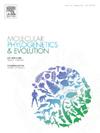Jumping through hoops: Structural rearrangements and accelerated mutation rates on Dendrodorididae (Mollusca: Nudibranchia) mitogenomes rumble their evolution
IF 3.6
1区 生物学
Q2 BIOCHEMISTRY & MOLECULAR BIOLOGY
引用次数: 0
Abstract
The systematics of the family Dendrodorididae, with only three valid genera, is a challenge for integrative taxonomists. Its members lack hard structures for morphological comparisons and their mitochondrial and nuclear markers provide contradictory phylogenetic signals, making phylogenetic reconstructions difficult. This molecular discordance has been hypothesized to be the result of nuclear pseudogenes or exogenous contamination. However, these hypotheses have not been tested. Here, we assembled the first genome drafts of seven Dendrodorididae species to investigate the evolutionary processes of this family. Two of the mitogenomes displayed an identical structural rearrangement involving the translocation of three coding genes and five tRNAs, described for the first time in nudibranchs. In addition, we found particularly high dN and dN/dS values and multiple insertions and deletions on the mitochondrial genes of smooth Dendrodoris. In contrast, nuclear single-copy ortholog genes showed no such mutational differences. Models of protein structures from mitochondrial genes are conserved, suggesting conserved functionality. Phylogenies using mitogenomic and nuclear data showed that species with rearranged mitogenomes form a clade, although Dendrodorididae relationships remained unresolved. The present study provides novel evidence for accelerated mutation rates in the mitogenomes of Dendrodorididae, which presumably have implications on respiratory adaptation, and highlights the importance of using genomic data to unveil rare evolutionary processes, crucial for correctly inferring phylogenies.
跳过圈圈:石斛科(软体动物门:裸鳃纲)有丝分裂基因组的结构重排和加速突变率推动了它们的进化。
石斛科仅有三个有效属,其系统学研究对综合分类学家来说是一个挑战。其成员缺乏用于形态学比较的坚硬结构,其线粒体和核标记提供了相互矛盾的系统发育信号,使得系统发育重建变得困难。这种分子上的不一致被假定为核假基因或外源污染的结果。然而,这些假设尚未得到验证。在这里,我们收集了 7 个树枝蛙科物种的首个基因组草案,以研究该科的进化过程。其中两个有丝分裂基因组显示了相同的结构重排,涉及三个编码基因和五个tRNA的易位,这在裸鳃亚目中还是首次被描述。此外,我们还发现光滑斛鱼的线粒体基因具有特别高的 dN 值和 dN/dS 值以及多个插入和缺失。相比之下,核单个拷贝同源基因没有显示出这种突变差异。线粒体基因的蛋白质结构模型是保守的,这表明其功能是保守的。利用有丝分裂基因组和核数据进行的系统发育显示,有丝分裂基因组重新排列的物种形成了一个支系,但鼠斛科的关系仍未解决。本研究提供了新的证据,证明石斛科的有丝分裂基因组突变率加快,这可能对呼吸适应有影响,并强调了利用基因组数据揭示罕见进化过程的重要性,这对正确推断系统进化至关重要。
本文章由计算机程序翻译,如有差异,请以英文原文为准。
求助全文
约1分钟内获得全文
求助全文
来源期刊
CiteScore
7.50
自引率
7.30%
发文量
249
审稿时长
7.5 months
期刊介绍:
Molecular Phylogenetics and Evolution is dedicated to bringing Darwin''s dream within grasp - to "have fairly true genealogical trees of each great kingdom of Nature." The journal provides a forum for molecular studies that advance our understanding of phylogeny and evolution, further the development of phylogenetically more accurate taxonomic classifications, and ultimately bring a unified classification for all the ramifying lines of life. Phylogeographic studies will be considered for publication if they offer EXCEPTIONAL theoretical or empirical advances.

 求助内容:
求助内容: 应助结果提醒方式:
应助结果提醒方式:


